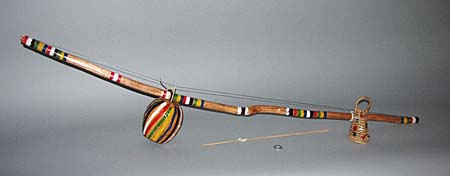
Owner: HWMC
Catalog#: LA-CHBW-01
Provenance: Alan Suits – Coyote’s Paw
Musical Bows
Brazil ‘Berimbau’
Brazil
Brazilian Capoeira
Wood, metal, gourd, rattan, seeds, paint
Mid-20th century
Length: 55 inches
Chordophones – Musical Bows
The berimbau, a type of single string musical bow, is mostly like an adaptation of the African gourd musical bow. It resembles the m’bulumbumba of southwest Angola with the same construction and played in a very similar way. By the twentieth century, the instrument became the foundation of music for the Brazilian capoeira. The jogo de capoeira (game of capoeira), was a Brazilian martial art form that combined self-defense, acrobatics, dance, music, and song. This accompanying instrument had come to be known as the berimbau, a Portuguese misnomer.
The berimbau consists of a bent wooden bow stave, made of beriba wood (Rollinia mucosa), that is strung with a single metal wire, called an arame. A dried, hollowed, open-backed gourd resonator—called a cabaça—is attached to the instrument near its lower end, and the resonator is held in place by a loop of string that passes through the top of the gourd and around both the wood and the wire of the bow.
When it is played, the berimbau is held in an upright position, with the open back of the gourd against the stomach. The little finger of the supporting hand is slipped under the string that secures the gourd to the bow, while the ring and middle fingers are wrapped around the wooden pole just above the gourd. The index finger and thumb manipulate the dobrão, a thick metal disc or smooth stone that is pressed against the wire to generate a buzzing timbre (repique). Held in the other hand is a thin stick, called a baqueta, and a small rattle, called a caxixi. Using the baqueta (stick) to strike the wire of the berimbau, the dobrão and cabaça are used to control the instrument’s pitch, timbre, and resonance. The berimbau player generates an array of discrete rhythms known as toques.
Resource: ‘Berimbau’, John M Schechter/Eric A. Galm. “The Groves Dictionary of Musical Instruments.” 2nd ed., Vol. 1., Laurence Libin, Editor in Chief. Oxford University Press, 2014.
